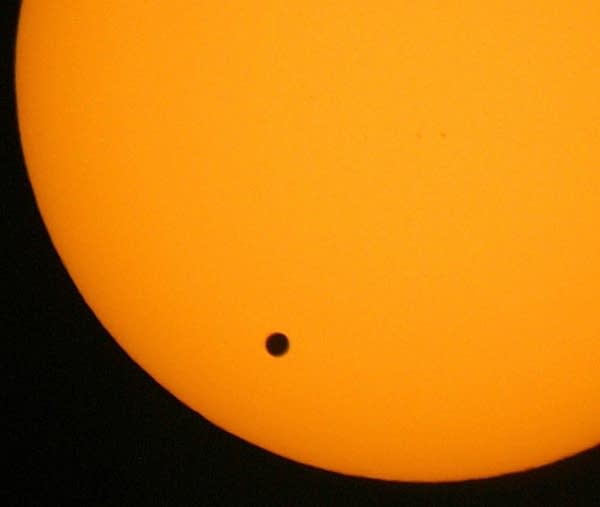Don't look! It's the transit of Venus

By OSKAR GARCIA, Associated Press
HONOLULU (AP) -- Stargazers around the world are setting up special telescopes and passing out cardboard eclipse glasses to view the once-in-a-lifetime celestial cameo of Venus passing in front of the sun.
The transit of Venus -- a planetary spectacle that won't occur again until 2117 -- won't be enough to significantly block the sun's light but it will give Earth's closest star a moving beauty mark. Venus is currently Earth's closest neighboring planet, although Mars occasionally has that distinction.
"In terms of rarity, to be here at a time when it's happening, you almost have to look at it," said Geoff Chester of the U.S. Naval Observatory, who saw the last transit in 2004. "It ain't going to happen again in my lifetime."
Create a More Connected Minnesota
MPR News is your trusted resource for the news you need. With your support, MPR News brings accessible, courageous journalism and authentic conversation to everyone - free of paywalls and barriers. Your gift makes a difference.
The transit is happening during a 6-hour, 40-minute span starting just after 6 p.m. EDT in the United States. What you can see and for how long depends on what the sun's doing in your region during that exact window, and the weather. Those in most areas of North and Central America will see the start of the transit until the sun sets, while those in Western Asia, the eastern half of Africa and most of Europe will catch the transit's end once the sun comes up.
Hawaii, Alaska, eastern Australian and eastern Asia including Japan, North and South Korea and eastern China will get the whole show since the entire transit will happen during daylight in those regions.
Don't stare directly at the sun without eclipse glasses, a properly filtered telescope or a strong welding visor. Permanent eye damage could result.
Astronomers across the globe are using the rarity of the moment to spark scientific curiosity among the public, and to document the transit with the latest technology available.
In Hawaii, university astronomers planned viewings at Waikiki Beach, Pearl Harbor and Ko Olina. At Waikiki, officials planned to show webcasts of the transit as seen from telescopes from volcanoes Mauna Kea on the Big Island and Haleakala on Maui.
NASA planned a watch party at its Goddard Visitor Center in Maryland with solar telescopes, images from its Solar Dynamics Observatory Mission and expert commentary and presentations. The observatory will produce "Hubble-quality" images, according to NASA's website.
Groups of scientists from the University of North Texas planned to watch from points in Alaska and Hawaii to recreate the 1769 expedition of British Capt. James Cook, who used the transit to calculate Earth's distance from the sun. The scientists will use atomic clocks, GPS and high-end telescopes to take measurements, and will use high-end video gear to capture time-lapse video.
This will be the seventh transit visible since German astronomer Johannes Kepler first predicted the phenomenon in the 17th century. Because of the shape and speed of Venus' orbit around the sun and its relationship to Earth's annual trip, transits occur in pairs separated by more than a century.
It's nowhere near as dramatic and awe-inspiring as a total solar eclipse, which sweeps a shadow across the Earth, but there will be six more of those this decade.
___ AP Science Writer Alicia Chang in Los Angeles and Associated Press writer Rachel D'Oro in Anchorage contributed to this report.


